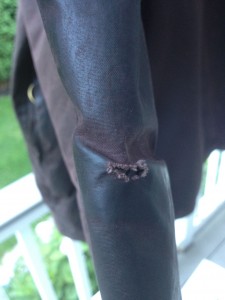Gentlemen: if in the course of your summer routine you find yourself spending some time at home without your better half and children–who remain in some delightful holiday locale while you return to your daily toil–a particularly appropriate way to pass a summer’s evening is to apply Barbour Thorn-Proof Dressing to one’s coat.
What better way to celebrate the season, whilst mindfully preparing for November’s tofu-pup hunt season in unremittingly foul weather, than to lovingly recondition this most loyal of garments? Indeed, why should gamekeepers and valets have all the fun? No task could be more simple, nor more rewarding in its execution. Follow the straightforward guidelines below for superior results every time.
1. Prepare your materials. You will need a salver of ice-cold water, a naturally harvested sponge, a thin cotton cloth (itself naturally harvested from a garment celebrating long-ago athletic triumphs against Little Three opponents), a small pot of boiling water, gutta-percha gloves, a hair-dryer, and of course a tin of Barbour Thorn-Proof Dressing. If you do not have a dedicated space for storing and maintaining your Barbour coats, take care not to attempt this procedure on shag carpeting or a squash court as excess wax may damage the finish.
2. Sponge down the entire waxed surface of the coat with the ice water. Pockets should be emptied and any residual snacks found therein can be eaten straightaway. Because it’s summer!
3. Place the tin of Barbour Thorn-Proof Dressing–but do not immerse it–in boiling water in a rustic hot pot that you keep just for this occasion in your Barbour shed. The intent is to gently melt the dressing to allow it to be spread across the coat. Failing that, you can lower the tin into a regular saucepan of boiling water on your electric stovetop. If you do accidentally immerse the tin, which may at this juncture start to appear rather smaller than those pictured in the Barbour Company’s instructional videos, on no account should you bellow f-bombs and subsequently splay out molten Thorn-Proof Dressing on your stovetop as though intending to rip off its control knobs Brazilian Wax-style.
4. Donning your gutta-percha gloves, dab your cotton cloth strip into the pool of wax collecting on the floor in front of the stove until you have absorbed a goodly amount. Placing the coat on some newspapers outside, briskly but smoothly apply the molten wax evenly across every waxed surface of the coat. Under some conditions, the wax may gather together thickly upon some areas of the coat like the ice packs crushing the boats of the Shackleton Expedition, leaving other areas only lightly glazed with what you must have faith is a sufficient amount of Thorn-Proof Dressing.
5. Working in full view of your neighbors, apply every last semi-molten drop of Thorn-Proof Dressing to the coat’s surface, attempting to maintain at least a plausible spectrum of Covered to Rubbed Slightly But Maybe Not Entirely Covered to Thorn-Piercing Depth across the coat’s various hills and crevices.
6. Go get the hair dryer, ensuring that you walk within the same set of waxy footprints between your stove and the back yard in order to minimize spillage. Blow hot air across the Thorn-Proof Dressing on the coat in order to diffuse it evenly and restore a factory finish. Or, blow hot air across the islands, eddies, and occasional hardened plugs of Thorn-Proof Dressing in order to diffuse it as well as you can and produce an entirely novel finish, resembling the striations of the hide of an animal that might be hunted by proper Barbour-coat-wearing gentry.
7. Hang the coat in open air in order to let the Thorn-Proof Dressing dry and to use this new hide pattern to intimidate the chipmunks and other prey animals that might otherwise dive into your composter and get all the good bits. You might consider just leaving the coat in this place year-round for that purpose.
Now sit back (but not on the waxy part of the floor) with a well-deserved beverage and salute your self-reliance. Next in the series: Vegan Taxidermy.

